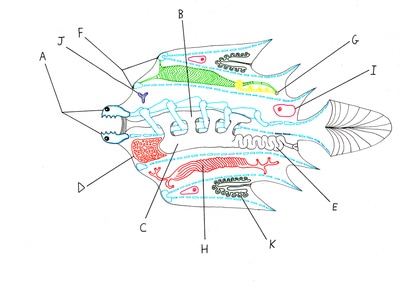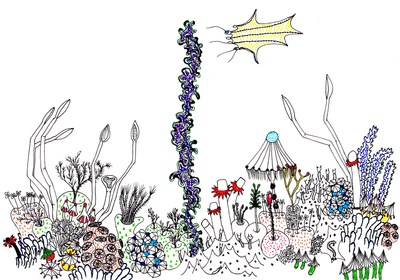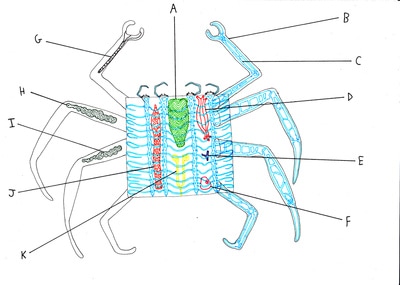|
Legacy by Greg Bear is a book whose story takes place on the planet Lamarckia, named after scientist Jean-Baptiste Lamarck, who is famous for his pre-Darwinian hypothesis of evolution through acquired traits that has since fallen into disfavor. There are only a few dozen genetically distinct organisms on Lamarckia, taking the form of vast forests or other biomes called ecos. Animal-like and plant-like objects are merely parts of the whole that perform their functions. These ecos compete with each other and steal genetic innovations from each other, giving them acquired traits, hence why the planet was named after Lamarck. While the core of the story is the human drama, there is much description of the biology that makes up the setting.
0 Comments
The free online magazine Astrovitae features artists, projects, and individual organisms from all across the speculative biology genre, stretching it to include even drawings of reimagined mythical creatures. They currently publish twice per year. The layout and graphics are professional, but most of the content is contributed directly from the artists without editing. They write about themselves, their goals, their attitudes towards art, but mostly about the life forms, and that’s what it’s all about.
Curious Archive is a YouTube channel covering an eclectic bunch of subjects including history, cryptids, myths, and speculative biology in all its flavors. It is doing what I had hoped for this blog to do, shining a light on spec projects and encouraging art. If you need inspiration to start your own project, watch the videos sometime. Serina is as good a place to start as any.
If the life of planet Kaimere looks familiar, that’s because it originally came from Earth, teleported by mysterious means over the eons. Many clades extinct on Earth continue to live on Kaimere. Felids, creodonts, and theropods share the same hunting grounds. Bats, birds, pterosaurs, and strange flying therapsids share the skies.
Keenan Taylor has written an anthology of short stories of the people who live on this world, available at Barnes and Noble. Concept art can be found on his DeviantArt page. Updates can be seen on his YouTube channel. Kalagari is the creation of YouTube user Ben Pebbles. It is a planet of purple plants with swimming fruits. There are also animals and green plants. I enjoy watching the animations of the seal-like and buffalo-like creatures. The narration style is humorous and tends to jump from one organism to the other by their ecological relationships. Watch the videos here.
Project Rose includes not just one, but three planets, Nusku, Mazu, and Ullr, all within the habitable zone of a red dwarf star. Nusku is tidally locked, giving it a permanent typhoon where it faces the sun, surrounded by desert, surrounded by temperate forest, surrounded by ice near the windy twilight zone. The “night” side of the planet is dead. Mazu is a water world with little or no dry land. Ullr is like a colder, larger version of Earth.
As of this writing, only Nusku life has been described and plants are just beginning to move onto land. They resemble purple mushrooms, ferns, or palms. There are two basic lineages of animals: Filter-feeding, radially-symmetrical animals evolved into bilaterally-symmetrical fish-like creatures, some with armor and some with jaws. Flat animals with four mouths and one anus evolved into burrowing, swimming, and barnacle-like forms, some with parapodia, shells, hair, backbones, beaks, hooked tentacles, “swords,” or “saws.” Some filter the water with all four mouths. Others bring water in two of the mouths, filter it for plankton, and expel it out the other two. Watch the ongoing saga on YouTube. The planet Almaishah is the creation of YouTube user Dapper Dino and its inhabitants are the collaborative effort of many speccers and artists. Every few months, the project enters a new phase, setting the clock forward ten million years and causing extinctions. New plants and animals are added, but must derive only from those species already in existence. Because it is a collaborative effort, there is some variety in the art style and the length and detail of the descriptions read aloud by Dapper Dino. The large-scale groupings of organisms are more diverse when everyone is trying to take things in different directions. Some focus on behavior, others internal anatomy, others external anatomy.
As of this writing, phase three has just ended. Life still lives primarily in the oceans, but a few animals have adapted to taking short strolls above the tide line. The biodiversity is exciting. The art is professional. There are boneless tetrapods, some resembling tiny horses or crocodiles, jellyfish-equivalents taking the roles of limpets, leaches, and corals, echinoderm-equivalents sometimes taking the roles of jellyfish, and segmented animals already diversified into forms vaguely reminiscent of fish, turtles, earthworms, shrimp, spiders, beetles, lobsters, swimming centipedes, and giant, blind, heavily-armored worms that slither along the bottom and eat whatever is stupid enough to stumble into their oral tentacles. There are purple plants filling the roles of seaweed, true plants, and corals. There are animal-like swimming green plants, some of which have lost their chlorophyll and become red plankton, and some of which have lost photosynthesis entirely and become vermiform detritivores. There are also animal-like radiotrophs that feed on the energy from radioisotopes, some of which have also developed photosynthesis and chemosynthesis. I don’t understand their anatomy at all. Watch the ongoing saga on YouTube. |
Like alien art? Check out my store.
Copyright © 2017



 RSS Feed
RSS Feed